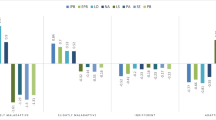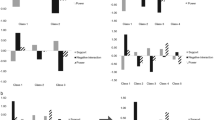Abstract
This study examined the way late adolescents separate from their parents. Emotional independence and conflictual independence toward mother and father were assessed. Emotional independence was defined as freedom from an excessive need for emotional support from the parents and conflictual independence as absence of guilt, mistrust, and anger toward parents. Students (18–22 years; N = 190) enrolled in higher education completed two scales of Hoffmann's Psychological Separation Inventory. Results indicated that girls more than boys need emotional support from their mothers (z = −3.101, p < .002). They express this need significantly more towards their mothers than towards their fathers (z = −4.194, p < .00003). The pattern of the girls' typical items demonstrated an ambivalence between reported dependence and demand for autonomy. The two types of independence (emotional and conflictual) were moderately correlated (r s = ∼.40). These findings support Gilligan's argument that connectedness plays a central role in the development of female adolescents. They speak for a multidimensional approach of the psychological separation process, which takes the type of independence and the children's and parents' gender into account.
Similar content being viewed by others
REFERENCES
Allen, J. P., Borman-Spurrell, E. B., and Hauser, S.T. (1996). Attachment theory as framework for understanding sequelae of severe adolescent psychopathology: An 11-year follow-up study. J. Consult. Clin. Psychol. 64: 254–263.
Blos, P. (1967). The second individuation process of adolescence. In The Adolescent Passage, International Universities Press, New York, pp. 161–170.
Campbell, E., Adams, G. R., and Dobson, W. R. (1984). Familial correlates of identity formation in late adolescence: A study of the predictive utility of connectedness and individuality in family relations. J. Youth Adolesc. 13: 509–525.
Frank, S. J., Pirsch, L. A., and Wright, V. C. (1990). Late adolescents' perceptions of their relationships with their parents: Relationships among deidealization, autonomy, relatedness, and insecurity and implications for adolescent adjustment and ego identity status. J. Youth Adolesc. 19: 571–588.
Fuhrman, T., and Holmbeck, G. N. (1995). A contextual moderator analysis of emotional autonomy and adjustment in adolescence. Child Dev. 66: 793–811.
Fulmer, R. H., Medalle, J., and Lord, D. A. (1982). Life cycles in transition: A family systems perspective on counseling the college student. J. Adolesc. 5: 195–217.
Gilligan, C. (1982). In a Different Voice: Psychological Theory and Women's Development, Harvard University Press, Cambridge, MA.
Grotevant, H. D. (1983). The contribution of the family to the facilitation of identity formation in early adolescence. J. Early Adolesc. 3: 225–237.
Hoffman, J. A. (1984). Psychological separation of late adolescents from their parents. J. Counsel. Psychol. 31: 170–178.
Holmbeck, G. N., and Hill, J. P. (1988). Storm and stress beliefs about adolescence: Prevalence, selfreported antecedents, and effects of an undergraduate course. J. Youth Adolesc. 17: 285–306.
Josselson, R. (1987). Finding Herself: Pathways to Identity Development in Women, Jossey-Bass, San Francisco.
Kenny, M. E. (1987). The extent and function of parental attachment among first-year college students. J. Youth Adolesc. 16: 17–28.
Lamborn, S. D., and Steinberg, L. (1993). Emotional autonomy redux: Revisiting Ryan and Lynch. Child Dev. 64: 483–499.
Lapsley, D. K., Rice, K. G., and Shadid, G. E. (1989). Psychological separation and adjustment to college. J. Counsel. Psychol. 36: 286–294.
Mahler, M. S., Pine, F., and Bergman, A. (1980). La naissance de l'être humain, Payot, Paris.
Masterson, J. F. (1982). L'adolescent borderline. In Feinstein, S. C., Giovacchini, P. L., and Miller, A. A. (eds.), Psychiatrie de l'adolescent, PUF, Paris, pp. 169–207.
McCurdy, S. J., and Scherman, A. (1996). Effects of family structure on the adolescent separationindividuation process. Adolescence 31: 307–319.
Moore, W. (1987). Parent-adolescent separation: The construction of adulthood by late adolescents. Dev. Psychol. 23: 298–307.
Newman, B. M. (1989). The changing nature of the parent-adolescent relationship from early to late adolescence. Adolescence 24: 915–924.
Offer, D., Ostrov, E., Howard, K. I., and Atkinson, R. (1988). The Teenage World: Adolescents' Self Image in Ten Countries, Plenum Press, New York.
Paterson, J. E., Field, J., and Pryor, J. (1994). Adolescents' perceptions of their attachment relationships with their mother, father, and friends. J. Youth Adolesc. 23: 579–601.
Paulson, S. E., and Sputa, C. L. (1996). Patterns of parenting during adolescence: Perceptions of adolescents and parents. Adolescence 31: 369–381.
Ryan, R. M., and Lynch, J. H. (1989). Emotional autonomy versus detachment: Revisiting the vicissitudes of adolescence and young adulthood. Child Dev. 60: 340–356.
Rosenstein, D. S., and Horowitz, H. A. (1996). Adolescent attachment and psychopathology. J. Consult. Clin. Psychol. 64: 244–253.
Ruebush, K.W. (1994). The mother-daughter relationship and psychological separation. J. Res. Adolesc. 4(3): 439–451.
Schultheiss, E. P., and Blustein, D. L. (1994). Role of adolescent-parent relationships in college student development and adjustment. J. Counsel. Psychol. 41: 248–255.
Siegel, S. (1988). Nonparametric Statistics for the Behavioral Sciences, McGraw-Hill, New York.
Steinberg, L. (1987). Recent research on the family at adolescence: The extent and nature of sex differences. J. Youth Adolesc. 16: 191–197.
Steinberg, L., and Silverberg, S. B. (1986). The vicissitudes of autonomy in early adolescence. Child Dev. 57: 841–851.
Surrey J. L. (1985). iSelf-in-Relation: A Theory of Women's Development (Work in Progress, No. 13), Wellesley, College, Wellesley, MA.
Van Wel, F. (1994). “I count my parents among my best friends”: Youths' bonds with parents and friends in the Netherlands. J. Marriage Family 56: 835–842.
Youniss, J., and Smollar, J. (1985). Adolescent Relations with Mothers, Fathers and Friends, University of Chicago Press, Chicago.
Author information
Authors and Affiliations
Rights and permissions
About this article
Cite this article
Geuzaine, C., Debry, M. & Liesens, V. Separation from Parents in Late Adolescence: The Same for Boys and Girls?. Journal of Youth and Adolescence 29, 79–91 (2000). https://doi.org/10.1023/A:1005173205791
Issue Date:
DOI: https://doi.org/10.1023/A:1005173205791




